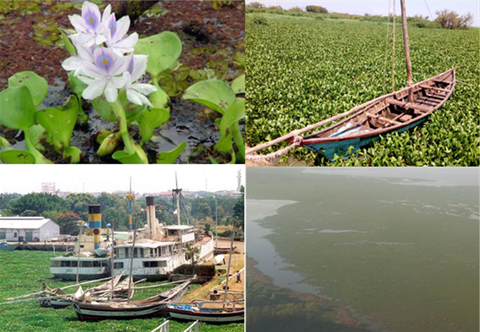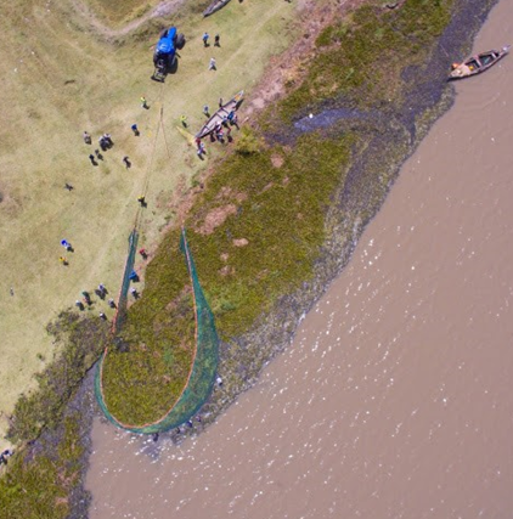Kenya Water Hyacinth
Water hyacinth (Eichhornia crassipes)—a free floating, perennial aquatic weed native to the Amazon Basin—is aggressively spreading around the globe, with dire ecological, economic, and social consequences. Once established, water hyacinth reproduces rapidly and commonly forms large, dense mats that obstruct navigation, block access to safe drinking water, drastically alter freshwater habitats and associated biotic communities, increase methane emissions, decimate traditional fisheries and local economies, and promote the spread of water-borne diseases. Water hyacinth is particularly widespread and impactful in large rivers and lakes in sub-Saharan countries in Africa. Lake Victoria—bordered by Kenya, Uganda, and Tanzania—is the largest lake in Africa and the second largest freshwater body of water, in terms of surface area, in the world. The lake is undergoing rapid change due to the proliferation of water hyacinth.
Although impacts vary by type and severity, communities affected by water hyacinth tend to suffer drastic economic losses, increased rates of malaria, schistosomiasis, and cholera, devastating food insecurity, and an erosion of community culture and way of life. The impacts of water hyacinth are profound at every level of society, but especially among those who depend on fish for a living. To cite one sobering example, many women who formerly worked as fishmongers in Kenyan fishing villages have turned to prostitution to support themselves and their families. This, in addition to increased rates of itinerancy among fishermen (traditionally male) seeking better fishing opportunities, has contributed to a surge in HIV infection rates and related deaths in fishing communities around Lake Victoria. Based on extensive surveys and testing, Ondondo et al. (2014) and Kwena et al. (2019) reported HIV prevalence among residents of Lake Victoria fishing communities in Kenya in 2013 ranged between 28 and 32 percent, respectively—several times the national average.
Shore-based and aerial photographs taken of water hyacinth in Winam Gulf, the Port of Kisumu, and Nyandiwa, Kenya. (Photo credits: EcoWB, SEALS).
In 2017, EcoWB began working in partnership with Kenyan scientists, NGOs, community representatives, government authorities, and others, to address the interrelated social and ecological impacts of water hyacinth in Winam Gulf, a relatively shallow, 56-km by 24-km embayment of Lake Victoria. Over the past several years, EcoWB and its local partners have invested thousands of labor hours into developing a practical, proven, cost-effective approach to reducing water hyacinth concentrations over large areas, thereby improving water quality, allowing nearshore habitats and associated biological communities to recover, restoring fishing opportunities, and eliminating conditions that favor the spread of water-borne diseases. EcoWB and its partners have carefully researched the various measures that have been employed to control water hyacinth, both around the world and in Winam Gulf in particular. EcoWB has also conducted spatial and temporal analyses of water hyacinth abundance and distribution in Winam Gulf using high resolution satellite imagery. EcoWB’s approach to the problem is designed to overcome obstacles and avoid mistakes of the past by addressing water hyacinth issues within a socio-ecological system framework. The key to our approach—what sets it apart from earlier attempts to eradicate water hyacinth in Lake Victoria—is that it recognizes the intrinsic linkages between environmental protection, community empowerment, and economic development.
Our goal is to work with our in-country partners to implement a scalable, replicable, and economically-viable strategy to engage disadvantaged fishers, their families, and local businesses to (1) remove water hyacinth, (2) convert it to affordably-priced, beneficial products (such as biogas, charcoal briquettes, biochar, fertilizer, animal feed, household items), and (3) restore and conserve riparian and nearshore aquatic habitats of Winam Gulf.
This approach is designed to benefit the environment while restoring livelihoods and creating employment opportunities for the people most directly affected by the proliferation of water hyacinth; namely, fishing-dependent residents living in rural areas who are poor and lack formal education, including men, women, and youth. EcoWB and its partners will train and assist community members in the establishment of several businesses to harvest, produce, and sell water hyacinth-derived products. Besides benefiting residents of fishing communities in Kisumu County, the project will benefit other residents in the region by increasing the availability and affordability of products that will be produced from water hyacinth. For example, water hyacinth charcoal briquettes are an efficient, inexpensive cooking fuel that many local residents much prefer over kerosene, propane, firewood, and charcoal made from trees cut down in distant highlands. To help address the underlying causes contributing to the proliferation of water hyacinth (i.e., eutrophication), restoration activities will include training and incentivizing members of the local community to plant trees, prevent erosion, convert organic waste into compost, and reduce the discharge of pollutants into aquatic ecosystems.
In 2019, with support from EcoWB and the assistance of community members, local partner Seaweed Aquatic Lake Services (SEALS) conducted pilot studies in Nyandiwa (an agricultural and fishing community located east of Kisumu on Winam Gulf) and confirmed the feasibility of hiring and training unemployed fisherman to mechanically harvest large quantities of water hyacinth from shore. The harvested water hyacinth was converted to compost and charcoal briquettes and sold to community residents. In addition to the 2019 pilot study, SEALS has successfully carried out pilot water hyacinth removals in the affected water bodies of Nairobi Dam, Winam Gulf, Lake Bogoria in Baringo, Kenya and has produced compost and charcoal briquettes from water hyacinth on a small scale since 2018.
Aerial view of mechanical removal of water hyacinth along Nyandiwa shoreline in Kenya. Note large net filled with water hyacinth being winched to shore. Photo was taken during the demonstration project conducted in February 2019 by SEALS, with support from EcoWB. (Photo credit: Tom Mboya, SEALS).
The project team is aggressively pursuing funding for the next phase of the project, which would include a 6-month, larger-scale pilot study and data collection period, followed by full-scale implementation of the proposed project activities. Ultimately, the project will produce commodities that can be sold at discounted prices to local residents and businesses, while generating enough income to cover operational costs. Surplus revenues would be used to fund expansion and environmental restoration and enhancement projects. In addition to providing a reliable source of revenue, the project will improve ecological conditions and biodiversity within the Gulf, promote economic stability and community resilience, and build capacity to ensure that water hyacinth utilization remains a long-term viable solution.
Literature Cited
- Kwena, Z.A., S.W. Njuguna, A. Ssetala, J. Seeley, L. Nielsen, J. De Bont, and E.A. Bukusi. 2019. HIV prevalence, spatial distribution and risk factors for HIV infection in the Kenyan fishing communities of Lake Victoria. PLoS One 14(3).
- Ondondo, R.O, Z.W. Nganga, S. Mpoke, M. Kiptoo, and E.A. Bukusi. 2014. Prevalence and Incidence of HIV Infection among Fishermen along Lake Victoria Beaches in Kisumu County, Kenya. World Journal of AIDS 4: 219–31.


